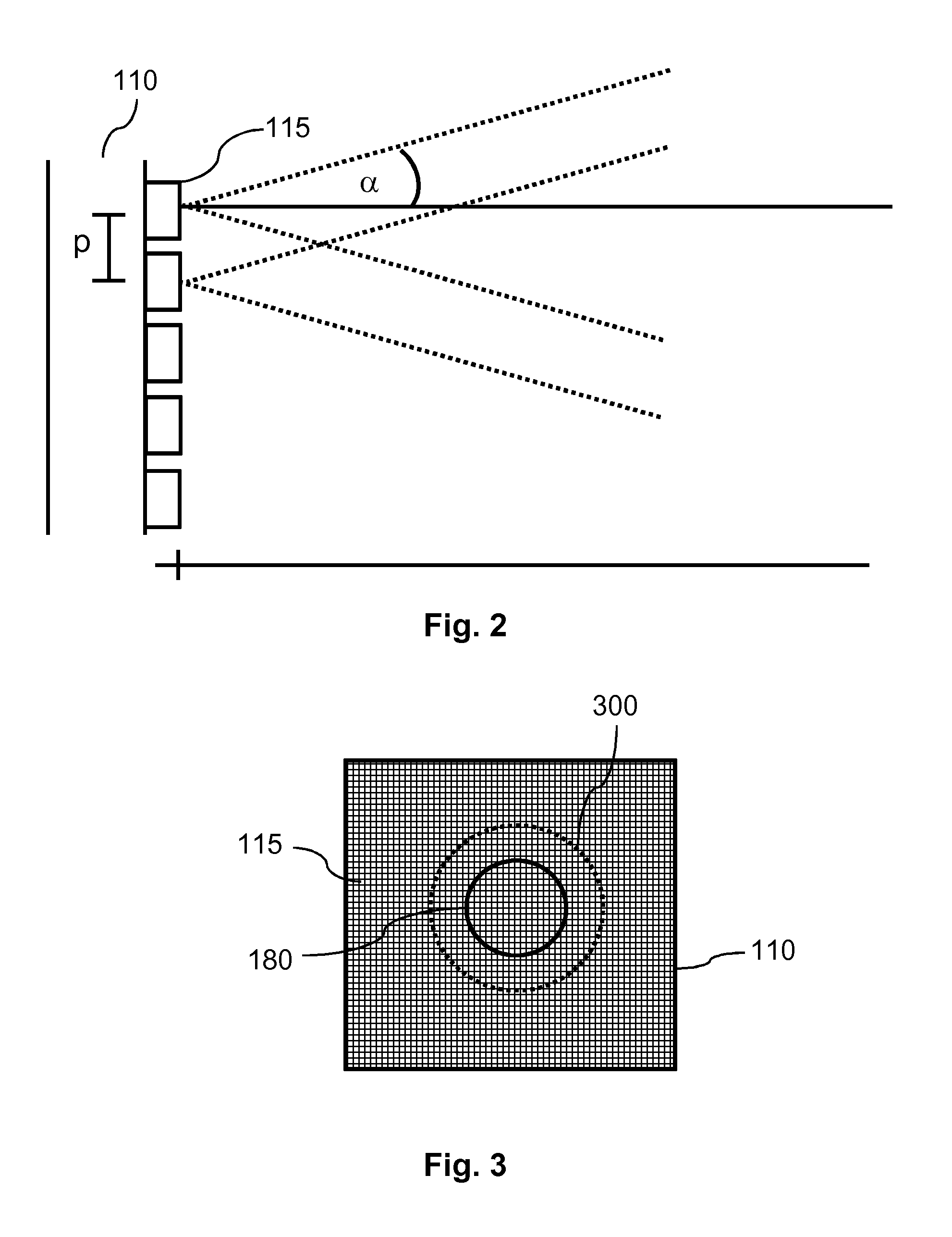Heating system comprising semiconductor light sources
a technology of semiconductor light source and heating system, which is applied in the direction of chemically reactive gas, coating, crystal growth process, etc., can solve the problems of unsatisfactory reliability and homogeneity of the heating process of the apparatus, and achieve the effect of improving the homogeneity of the temperature distribution, reducing the required heating power, and improving the reliability of the heating system
- Summary
- Abstract
- Description
- Claims
- Application Information
AI Technical Summary
Benefits of technology
Problems solved by technology
Method used
Image
Examples
first embodiment
[0075]FIG. 1 shows a principal sketch of a cross section of a heating system 100. The heating system comprises one sub module 110 with a multitude of semiconductor light sources 115 like VCSEL. The VCSEL emit laser light to an object 150 with a heating surface 180 with a diameter D at a distance A to the light emitting surface of the VCSEL. The heating surface 180 does not cover the entire upper surface of the object 150 next to the VCSEL. The distance A, the pitch between the VCSELs and the halve divergence angle a of the VCSEL are arranged such that an area element of the heating surface 180 is illuminated by means of at least 50 VCSEL. The divergence angle is defined as the angle where the intensity emitted by a semiconductor light source is reduced to 1 / e2 of the maximum intensity emitted by specific light source (e Euler number 2,71 . . . ).
[0076]For a square arrangement of the light sources with the pitch p this can be achieved by fulfilling the equation π (A tan α)2>50p2. The...
second embodiment
[0080]FIG. 3 shows a principal sketch of a heating system 100. The heating system 100 is shown from the perspective of the heating surface 180 of the object 150. The area 300 of the heating surface 180 illuminated by one semiconductor light source 115 is indicated by the dotted circle representing the line at which 1 / e2 of the maximum intensity received by the heating surface from the respective semiconductor light source is received. The semiconductor light sources 115 are indicated as squares on the sub module 110. Taking an area element near or at the center of the heating surface 180 (e.g. one of the squares),it's obvious that the light emitted by much more than 50 semiconductor light sources 115 overlaps at the respective area element of the heating surface 180. The minimum size of the sub module 110 in order to provide a homogeneous illumination has in this embodiment to be at least equal to the sum of the diameter of the heating surface 180 and the diameter of the area 300. L...
third embodiment
[0081]FIG. 4 shows a principal sketch of a cross section of a heating system. FIG. 5 shows a top view of the heating system 100 shown in FIG. 4 wherein the dashed line 510 indicates the line of the cross section shown in FIG. 4. Two groups of sub modules 110 with a multitude of semiconductor light sources are shown. Each sub module 110 of the first group of sub modules 410 emits light covering the whole heating surface 180 of the object 150 as indicated by the dotted lines. An idealized example of an intensity profile 620 provided by a sub module 110 of the first group of sub modules 410 is shown in FIG. 6. The intensity is essentially constant across the diameter D of the heating surface 180. In reality the intensity profile may be trapezoidal such that the area of constant intensity has to cover the whole heating surface 180. The sub modules 110 of the second group of sub modules 420 emits light covering only parts of the heating surface 180 of the object 150 as indicated by the d...
PUM
| Property | Measurement | Unit |
|---|---|---|
| processing temperature | aaaaa | aaaaa |
| temperature | aaaaa | aaaaa |
| temperature | aaaaa | aaaaa |
Abstract
Description
Claims
Application Information
 Login to View More
Login to View More - R&D
- Intellectual Property
- Life Sciences
- Materials
- Tech Scout
- Unparalleled Data Quality
- Higher Quality Content
- 60% Fewer Hallucinations
Browse by: Latest US Patents, China's latest patents, Technical Efficacy Thesaurus, Application Domain, Technology Topic, Popular Technical Reports.
© 2025 PatSnap. All rights reserved.Legal|Privacy policy|Modern Slavery Act Transparency Statement|Sitemap|About US| Contact US: help@patsnap.com



